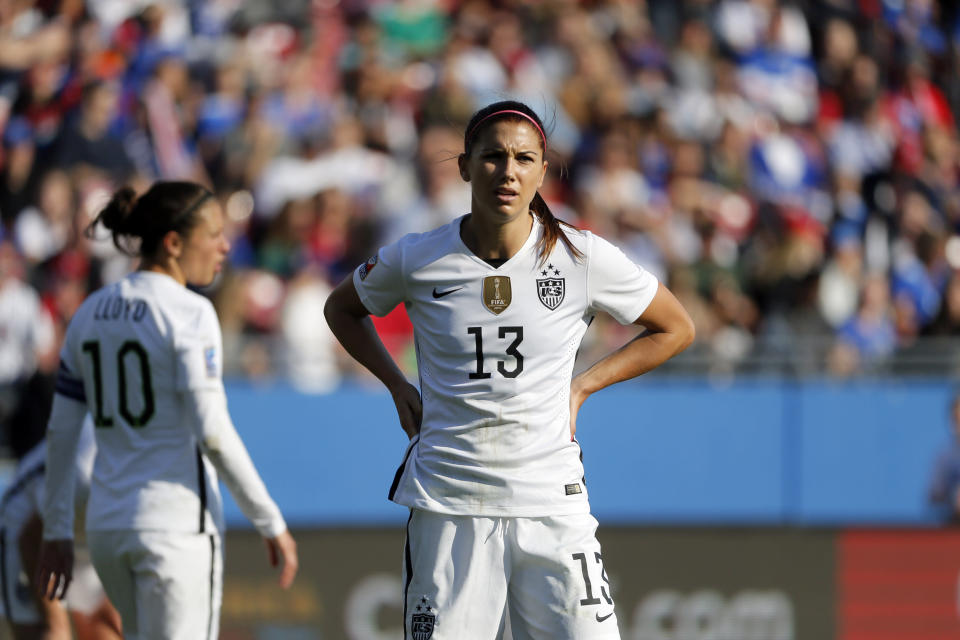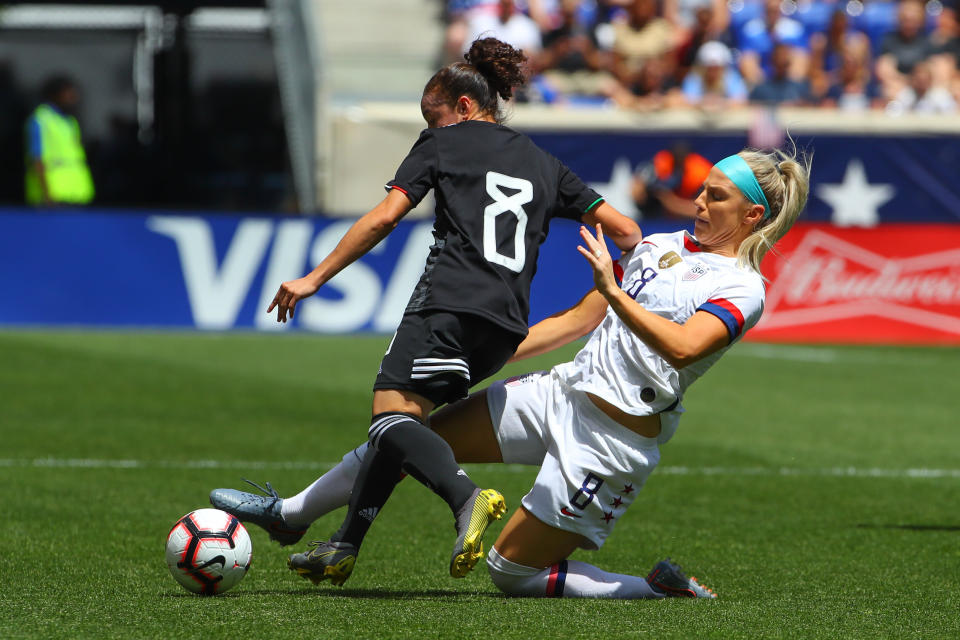What are the worst-case World Cup scenarios for the USWNT, and how could it weather them?
Winning a World Cup often comes down to depth. Injuries, illness, red cards, yellow-card suspension – teams can hit trouble in all sorts of ways and they have to be ready for it.
The U.S. women's national team has perhaps the deepest talent pool in the world, but their World Cup roster depth is imperfect. It's not that the Americans can't weather a storm or two while in France, but coach Jill Ellis might have to make some unexpected moves to do it.
With the Women's World Cup kicking off Friday and the U.S. starting its campaign on Tuesday against Thailand, here is a look at some of the worst-case scenarios the Americans could encounter and how they'd deal with them.
Scenario: Alex Morgan can't play
The attack has plenty of other potent pieces, but with 28 goals in her last 36 games – including a goal per game through an undefeated 2018 – it's clear that if Morgan has a good game, so does the USWNT.
But Morgan has been no stranger to injury over the years, having missed a significant chunk of the 2015 World Cup due to lingering problems. Notably, the USWNT's performance improved in Canada once Morgan was fit.
So how could the U.S. mitigate the absence of Morgan this time around? In this case, Ellis has plenty of options.
Christen Press has transformed herself into a winger and figures to play a role off the bench, but her true calling has always been as a target striker. The problem is that Press is a very different type of forward than Morgan.
While Morgan is at her best when she can race in behind backlines or float wide and take shots from tough angles, Press is comfortable sitting as centrally as possible and taking on defenders face-up to goal.

Instead, Ellis could start Carli Lloyd, who has made the full transition from attacking midfielder to out-and-out striker. But again, Lloyd is a different striker – her game is less about mobility and speed and it's more about making smart runs, getting into good spots and being capable of scoring in a variety of ways.
If the USWNT wants to play a relatively similar style as it does with Morgan on the field – while not dipping into potent "super sub" options like Press and Lloyd – then Jessica McDonald may fit the bill.
McDonald was one of the top scorers in the NWSL last year and led the league in assists. She can race in behind backlines, but she's also adept at hold-up play to create opportunities for her teammates, just like Morgan.
Otherwise, if McDonald isn't a replacement for Morgan, why is she on the roster? The fact is, the U.S. team didn't need another striker and Ellis is only bringing seven defenders for four positions, which is a bit thin.
A calculation was made somewhere along the way that McDonald could be useful, and it just may be part of the Alex Morgan backup plan.
Scenario: Crystal Dunn can't play
From a roster-construction standpoint, this may be the most difficult problem to solve. There's no other left back on the squad, and Ellis will likely need to shuffle players around to find a solution.
Ellis could put Tierna Davidson there, as she has in some friendly matches. But the 20-year-old Davidson is the youngest, least experienced player on the roster. If Ellis' roster construction tells us anything – including the omission of actual left back Casey Short – it's that Ellis prefers players who have competed in World Cups before.
That's why Ellis would probably instead opt to shift Kelley O'Hara, the starting right back, over to the left, where she played every minute of the 2012 Olympics.
That, of course, then leaves an open spot on the right. The depth pieces on the right are Emily Sonnett and Ali Krieger, and it's unclear who would deserve the starting nod.

Krieger is far more experienced, having played nearly every minute of the 2015 World Cup in that right back role, but she has been out of the team for the past two years until her surprise inclusion on the World Cup roster.
Sonnett, meanwhile, is the player who has started at right back when O'Hara has been out. But Sonnett is actually a center back for her club, and she's never played in a major tournament.
It may not be a perfect solution, but our best guess that is if Dunn couldn't play, O'Hara would slot to the left and Krieger would take the right back spot. Ellis has talked too much about selecting players she knows can handle "the pressure cooker of a World Cup" to throw a rookie into such an important role.
Scenario: Either Becky Sauerbrunn or Abby Dahlkemper can't play
Sensing a theme about backline depth? Just as the fullback positions are vulnerable to losing even one starter, the center back pairing is in a similar situation.
To be clear, losing Sauerbrunn would be a bigger loss than Dahlkemper. That's no dig at Dahlkemper – the reality is Sauerbrunn offers experience and leadership that no one else can match along the backline.
But whether it's Sauerbrunn or Dahlkemper, if one of Ellis' preferred center backs can't play, then Ellis is forced into another tough decision.
Again, Ellis could opt to play Davidson, but she's young, inexperienced, and despite being very good, she has also had games where a bad moment seemed to get in her head and unravel her. That's something Ellis will probably go out of her way to avoid in a World Cup.
Krieger is also an option. She has played as a center back for her club, the Orlando Pride, off and on. But the role is so much about having an understanding with players on either side that it's hard to see Krieger playing that role for the USWNT in a World Cup without being tested there in a few friendlies first.
Thus, it's a good bet that the solution would be taking Julie Ertz, the starting defensive midfielder, and slotting her into the backline.
Again, this is an unorthodox way to build depth, which typically involves taking a non-starter off the bench to plug a hole. Just as using the starting right back as the second-choice left back creates a lot of reshuffling, using the team's defensive midfielder as a next-choice center back will have a ripple effect – but it looks like that's what Ellis has in mind.
After all, even after the point where Ellis insisted she was done experimenting, Ertz has consistently dropped into the backline for the U.S. in their pre-World Cup tune-up matches. That suggests Ellis sees it as a real possibility that Ertz will need to reprise the role she played in 2015.

If Ertz does move to center back, that changes the look and functionality of the central midfield. No one on the team provides the sort physical line-shielding play of Ertz, not since Ellis opted to leave McCall Zerboni off the World Cup roster. That has left the U.S. with one true defensive midfielder on its roster in Ertz, and yet it wouldn't be a surprise to see Ertz abandon that role for the backline.
No one can really take Ertz's place and serve the same function, but Ellis will probably look to Samantha Mewis to take the vacant central midfield spot, and Lindsey Horan might drop into Ertz's spot. Although Horan is an effective attacking presence, she is capable of winning the ball, which is what the USWNT needs to stop oncoming attacks.
In the NWSL last year, Horan was involved in more duels, or challenges for 50/50 balls, than any other player in the league. And she won the ball 321 times, which is 116 more than anyone else. She's not quite the tackling disrupter that Ertz is, but no one else on the roster is. Horan, it should be noted, was second in goals in the NWSL last season too, but with all the goal-scorers on the USWNT, Horan's ball-winning ability is her most important asset.
Scenario: Rose Lavelle can't play
How do you take an attack that has Alex Morgan, Tobin Heath and Megan Rapinoe, and then make it better? You put a player like Lavelle right in the middle of the group, and let her pull the strings in the attack.
Lavelle is a unique player for the USWNT and there's no one else on the roster quite like her. She's a playmaking No. 10, which means she can combine in tight spaces, deliver line-breaking passes, and her creativity can generate opportunities on goal.
Her ability to serve as a maestro in the center of the attack is crucial because, without it, the USWNT tends to generate the bulk of its attack from the wings, whether it's coming from players like Heath and Rapinoe, or attacking fullbacks like O'Hara and Dunn.
In 2016, when the USWNT suffered the worst loss in program history against Sweden, part of the problem was its defensive approach, but another part of it was that the Americans were so one-dimensional in their attack. They crossed the ball a whopping 38 times and lacked a player like Lavelle who could work the ball centrally.
So what could the USWNT do without Lavelle if there's not another player on the roster who plays like her? The best bet: bring on Mewis.
Yes, we already discussed having Mewis replace Ertz in the defensive midfield and switch with Horan if necessary, and there's a reason for that: Mewis is the most well-rounded midfielder of the bunch. She may not be the best at any one thing, but she can do everything well.
What Mewis might be able to do in Lavelle's place is rip some shots outside the penalty area, which is something she does more than any other midfielder on the team.
Those sorts of shots can force defenders into an uncomfortable scenario where they have to decide how much and where to pressure Mewis. That can open up space.
Caitlin Murray is a contributor to Yahoo Sports and her book about the U.S. women’s national team, The National Team: The Inside Story of the Women Who Changed Soccer, is out now. Follow her on Twitter @caitlinmurr.
More from Yahoo Sports:

